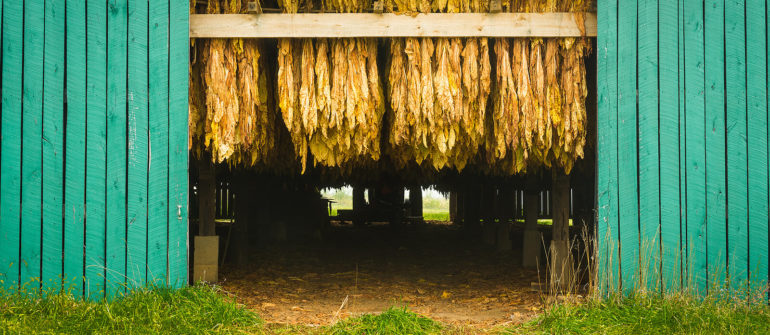It’s easy to overlook the vital processes tobacco goes through on its journey to become the cigar blend you know and love.
To become a cigar, tobacco must be cured, which involves drying in the leaves. Considered an art for many years, it’s performed after harvesting the leaves from the field.
Like most plants, when raw and freshly picked, they’ll still be lush and full of moisture, meaning they are too wet to ignite. By methodically extracting the excess moisture from the leaves, they are then suitable for use in the production of a cigar.
Tobacco curing is sometimes referred to as color curing because, as curing takes effect, the color of the leaf will invariably transform. This is because its chlorophyll content is being altered. Chlorophyll is the pigment that gives plants or leaves their typical green color but will sport a brownish-yellow look after curing has taken effect.
Curing consists of four essential steps: wilting, yellowing, coloring, and drying. Each of these stages involves physical and chemical changes in the leaf, which are carefully managed in order to achieve the required qualities of tobacco.
Types of tobacco curing
There are four main ways of curing tobacco. Curing methods vary depending on the type of tobacco, but they must be carefully controlled to bring out the different aromas and characteristics of each tobacco leaf.
All of these curing methods mark the first step in the manufacturing process and are essential in bringing different blends to the table. This allows cigar smokers to expand their palate and find similar stogies that fall under their preferred method of curing.
Tobacco curing has evolved over the course of centuries, in particular through our understanding of the leaf from a scientific perspective. Let’s take a look at the different practices and how they impact color, strength, and flavor profile.
Air cured tobacco
One of the first methods used for curing tobacco, air-cured tobacco leaves usually have high nicotine content. Air-cured tobacco is where the tobacco is hung up in well-ventilated barns and allowed to dry over a period of one to two months. It’s low in sugar content, which gives the tobacco smoke a light, smooth, semi-sweet flavor.
Early settlers have described how Native Americans would dry their tobacco leaves after a harvest, either in the sun or in the shades of their huts. The leaves were initially piled in heaps to dry until they realized that hanging the tobacco was far more effective.
Sun cured tobacco
Sun-curing tobacco is the most natural form of tobacco curing. The tobacco is exposed to direct sunlight for a couple of days and left to dry until it’s brown and withered. Unlike air-cured tobacco, sun-cured tobaccos are not hung up in a barn – they’re spread out on racks.
This process is mostly used in countries that produce oriental leaves, particularly those in Asia and the Mediterranean region where rain is scarce and there are plenty of rays. When sun-cured, the tobacco loses a significant amount of weight (sometimes up to 90%) due to the loss of moisture.
Typically, sun-dried tobacco is low in nicotine and has a sweeter taste. This is because the rapid drying locks in some of the natural sugars. Sun cured tobaccos can also offer a herbal and spicy aroma to complement the extra sweetness.
Flue cured tobacco
A 19th-century technique discovered by accident, flue-cured tobacco refers to the type of curing barn used to dry the tobacco leaves. These smoke-free curing barns have pipes or chimney-like flues, which run from external fed fire boxes without directly exposing the tobacco to smoke or fire.
The heat circulates throughout the enclosure, gradually raising its temperature over the course of the curing to dry the tobacco. This results in bright yellow leaves that are associated with Virginia or bright tobacco. Once all the moisture has been removed, the tobacco is taken from the flue-curing barn and baled.
As a result of technological advancements, propane is now often used as the heat source, enabling farmers greater control over the temperature and humidity. Of all the curing methods, flue-cured tobacco makes up 90% of the tobacco produced in the USA each year.
Flue-cured tobacco contains a high sugar content and is rich in natural tannins, which gives it a mild but sweet aroma.
Fired cured tobacco
The fire curing process bears some similarities to air curing, as the tobacco leaves are hung up in a barn to dry. However, between the second and sixth day, open wood fires are kindled between the leaves on a continuous or intermittent low smolder to impart a distinctively smoky, woodsy flavor. The barn needs to be tightly sealed to keep the smoke inside.
This method of curing yields tobacco that is low in sugar and high in nicotine, and takes anything from three days up to ten weeks. Due to their potent flavor, fire-cured tobaccos tend to be used as condimental tobacco.
